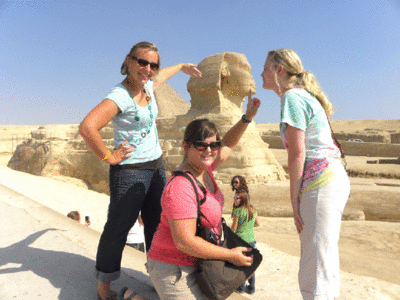
Sometimes it would seem that we present so much information that new travelers to Egypt, seeking a classical tour, may be overwhelmed. There are so many sites to see and things to do in Egypt that a relatively short trip may seem impossible. Our coverage of Egypt is extensive, but in this Special Edition, we will outline the hot spots of a classical tour, and why the areas are so important.
Most classical Egyptian tours are based on the most important pharaonic monuments, or rather, clusters of important monuments. For example, there are well over 100 pyramids in Egypt and taking the time to see all of these would involve an extensive trip. However, the most important of these, and the ones most visitors wish to see are all within a short trip from Cairo, and located near Giza just outside Cairo, and Saqqara to the south.
However, most classical tours should touch upon the non-pharaonic monuments in the area that one is visiting. For example, it would be disheartening to be in Cairo for a trip of a lifetime without viewing a few of the Christian and Islamic (medieval) sites.
Most brief, classical tours should cover basically three principle areas, with possible extensions. These include the area in and around Cairo, Luxor and Aswan. Certainly there are many other sites to see in Egypt, but for a brief visit of a week to ten days, these three areas will fill the agenda.
Cairo (And Surrounding Area)
Of these areas, most of the time should be spent in Cairo. Not only are their large clusters of monuments around Cairo, but they are some of the most important in Egypt. There are basically five areas in and around Cairo that should be and probably can be explored in a short trip. As mentioned above, these include the pharaonic sites of Giza, Saqqara and Memphis, as well as Old Cairo (Coptic, or Christian Cairo) and Islamic (Medieval) Cairo. In addition, most people will wish to visit the Egyptian Museum and if time permits, most Christians should include the Coptic Museum in their agenda.
Giza:When one thinks of Egypt, one thinks of Pyramids, and the Pyramids one thinks of are in Giza. Here are the three Great Pyramids consisting of the Pyramids of Menkaure, Chephren and Cheops. Of these, the Pyramid of Cheops is the oldest, and the largest in Egypt, and is often referred to as the Great Pyramid. However, at the time of writing of this article, while all of these Pyramids may be viewed externally, the inside of the Pyramid of Cheops is limited to 300 visitors per day on a first come first served basis Also, the Pyramid of Mycerinus is completely closed for internal visits due to its restoration. Of course there are other sites to see at Giza, including the famous Sphinx, as well as the three queen's Pyramids.
Memphis:Memphis, founded around 3,100 BC, really has the least to see, of the pharaonic sites around Cairo, but its importance in history is unchallenged, as the worlds first seat of civilized power. Memphis was the first capital of Egypt, and dates to the origin of recorded history. It was the city that Menes built, and which prospered for thousands of years.
Saqqara: Saqqara was the early necropolis (cemetery) of Memphis, and contains Pyramids which are older then in Giza. In fact, Pyramids located at Saqqara are not only older, but display an evolution of Pyramid building, such as the Bent Pyramid.
Old Cairo: Coptic Cairo, or more correctly, Old Cairo, predates Cairo itself to the village that was once Fort Babylon. Here, one finds some of the earliest Christian churches in the World and indeed the path of the Holy Family while in Egypt. The walls of Fort Babylon, a Roman fortress can still be seen, and built upon them the Hanging Church of the Virgin Mary.
Islamic Cairo: Though many western visitors may believe they have little interest in Islamic Cairo, one must remember that this is also medieval Cairo, where
Luxor (And Surrounding Area)
Luxor is well known though out the world as the largest open air museum. Actually, Luxor is made up of three areas. They consist of Luxor itself and its temple, Karnak and the Temple of Karnak, and Thebes, which was the name of the ancient city and now refers to the west bank where there is located several large necropolises, including the Valley of the Kings and the Valley of the Queens.
Aswan (And Surrounding Area)
Aswan is a traditional tourist area in Egypt, located in Egypt's extreme south, and is interesting for many different reasons. Like Cairo, but unlike Luxor, there is more to see and do here then just visit pharaonic monuments. Lake Nasser and one of the world's largest dams is nearby, along with the garden island of Kitchener. However, most short tours do not provide the time to visit many of the sites around Aswan. Primarily, they focus on Edfu and the Temple of Horus, the Temple of Kom-Ombo, Philae and Abu Simbel in further south in what was once Nubia. All of these great temples and shrines are significant. For example, Philae was the last pagan temple in Egypt, lasting well into the Christian era.



ساحة النقاش